Mingyang Song
R-Capsule: Compressing High-Level Plans for Efficient Large Language Model Reasoning
Sep 26, 2025Abstract:Chain-of-Thought (CoT) prompting helps Large Language Models (LLMs) tackle complex reasoning by eliciting explicit step-by-step rationales. However, CoT's verbosity increases latency and memory usage and may propagate early errors across long chains. We propose the Reasoning Capsule (R-Capsule), a framework that aims to combine the efficiency of latent reasoning with the transparency of explicit CoT. The core idea is to compress the high-level plan into a small set of learned latent tokens (a Reasoning Capsule) while keeping execution steps lightweight or explicit. This hybrid approach is inspired by the Information Bottleneck (IB) principle, where we encourage the capsule to be approximately minimal yet sufficient for the task. Minimality is encouraged via a low-capacity bottleneck, which helps improve efficiency. Sufficiency is encouraged via a dual objective: a primary task loss for answer accuracy and an auxiliary plan-reconstruction loss that encourages the capsule to faithfully represent the original textual plan. The reconstruction objective helps ground the latent space, thereby improving interpretability and reducing the use of uninformative shortcuts. Our framework strikes a balance between efficiency, accuracy, and interpretability, thereby reducing the visible token footprint of reasoning while maintaining or improving accuracy on complex benchmarks. Our codes are available at: https://anonymous.4open.science/r/Reasoning-Capsule-7BE0
Hunyuan-MT Technical Report
Sep 05, 2025Abstract:In this report, we introduce Hunyuan-MT-7B, our first open-source multilingual translation model, which supports bidirectional translation across 33 major languages and places a special emphasis on translation between Mandarin and several ethnic minority languages as well as dialects. Furthermore, to serve and address diverse translation scenarios and enhance model performance at test time, we introduce Hunyuan-MT-Chimera-7B, a translation model inspired by the slow thinking mode. This model integrates multiple outputs generated by the Hunyuan-MT-7B model under varying parameter settings, thereby achieving performance superior to that of conventional slow-thinking models based on Chain-of-Thought (CoT). The development of our models follows a holistic training process specifically engineered for multilingual translation, which begins with general and MT-oriented pre-training to build foundational capabilities, proceeds to Supervised Fine-Tuning (SFT) for task-specific adaptation, and culminates in advanced alignment through Reinforcement Learning (RL) and weak-to-strong RL. Through comprehensive experimentation, we demonstrate that both Hunyuan-MT-7B and Hunyuan-MT-Chimera-7B significantly outperform all translation-specific models of comparable parameter size and most of the SOTA large models, particularly on the task of translation between Mandarin and minority languages as well as dialects. In the WMT2025 shared task (General Machine Translation), our models demonstrate state-of-the-art performance, ranking first in 30 out of 31 language pairs. This result highlights the robustness of our models across a diverse linguistic spectrum, encompassing high-resource languages such as Chinese, English, and Japanese, as well as low-resource languages including Czech, Marathi, Estonian, and Icelandic.
HoPE: Hyperbolic Rotary Positional Encoding for Stable Long-Range Dependency Modeling in Large Language Models
Sep 05, 2025Abstract:Positional encoding mechanisms enable Transformers to model sequential structure and long-range dependencies in text. While absolute positional encodings struggle with extrapolation to longer sequences due to fixed positional representations, and relative approaches like Alibi exhibit performance degradation on extremely long contexts, the widely-used Rotary Positional Encoding (RoPE) introduces oscillatory attention patterns that hinder stable long-distance dependency modelling. We address these limitations through a geometric reformulation of positional encoding. Drawing inspiration from Lorentz transformations in hyperbolic geometry, we propose Hyperbolic Rotary Positional Encoding (HoPE), which leverages hyperbolic functions to implement Lorentz rotations on token representations. Theoretical analysis demonstrates that RoPE is a special case of our generalized formulation. HoPE fundamentally resolves RoPE's slation issues by enforcing monotonic decay of attention weights with increasing token distances. Extensive experimental results, including perplexity evaluations under several extended sequence benchmarks, show that HoPE consistently exceeds existing positional encoding methods. These findings underscore HoPE's enhanced capacity for representing and generalizing long-range dependencies. Data and code will be available.
Spline Deformation Field
Jul 10, 2025
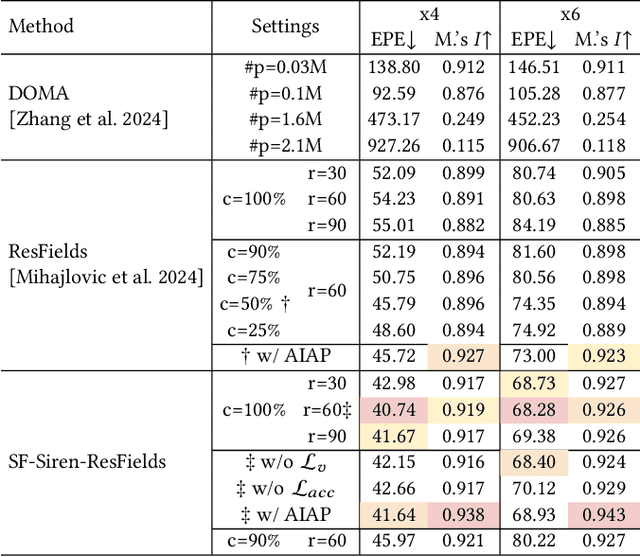

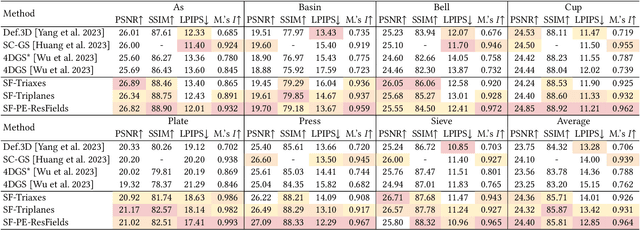
Abstract:Trajectory modeling of dense points usually employs implicit deformation fields, represented as neural networks that map coordinates to relate canonical spatial positions to temporal offsets. However, the inductive biases inherent in neural networks can hinder spatial coherence in ill-posed scenarios. Current methods focus either on enhancing encoding strategies for deformation fields, often resulting in opaque and less intuitive models, or adopt explicit techniques like linear blend skinning, which rely on heuristic-based node initialization. Additionally, the potential of implicit representations for interpolating sparse temporal signals remains under-explored. To address these challenges, we propose a spline-based trajectory representation, where the number of knots explicitly determines the degrees of freedom. This approach enables efficient analytical derivation of velocities, preserving spatial coherence and accelerations, while mitigating temporal fluctuations. To model knot characteristics in both spatial and temporal domains, we introduce a novel low-rank time-variant spatial encoding, replacing conventional coupled spatiotemporal techniques. Our method demonstrates superior performance in temporal interpolation for fitting continuous fields with sparse inputs. Furthermore, it achieves competitive dynamic scene reconstruction quality compared to state-of-the-art methods while enhancing motion coherence without relying on linear blend skinning or as-rigid-as-possible constraints.
TAT-R1: Terminology-Aware Translation with Reinforcement Learning and Word Alignment
May 27, 2025Abstract:Recently, deep reasoning large language models(LLMs) like DeepSeek-R1 have made significant progress in tasks such as mathematics and coding. Inspired by this, several studies have employed reinforcement learning(RL) to enhance models' deep reasoning capabilities and improve machine translation(MT) quality. However, the terminology translation, an essential task in MT, remains unexplored in deep reasoning LLMs. In this paper, we propose \textbf{TAT-R1}, a terminology-aware translation model trained with reinforcement learning and word alignment. Specifically, we first extract the keyword translation pairs using a word alignment model. Then we carefully design three types of rule-based alignment rewards with the extracted alignment relationships. With those alignment rewards, the RL-trained translation model can learn to focus on the accurate translation of key information, including terminology in the source text. Experimental results show the effectiveness of TAT-R1. Our model significantly improves terminology translation accuracy compared to the baseline models while maintaining comparable performance on general translation tasks. In addition, we conduct detailed ablation studies of the DeepSeek-R1-like training paradigm for machine translation and reveal several key findings.
Walk Before You Run! Concise LLM Reasoning via Reinforcement Learning
May 27, 2025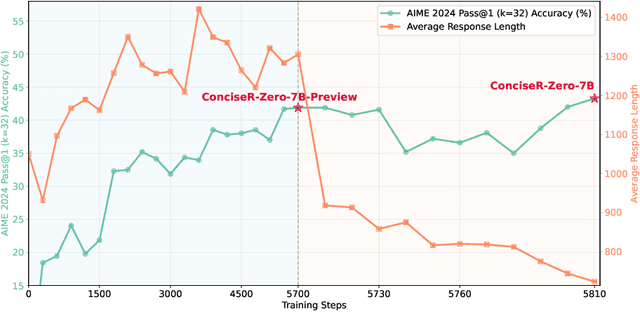
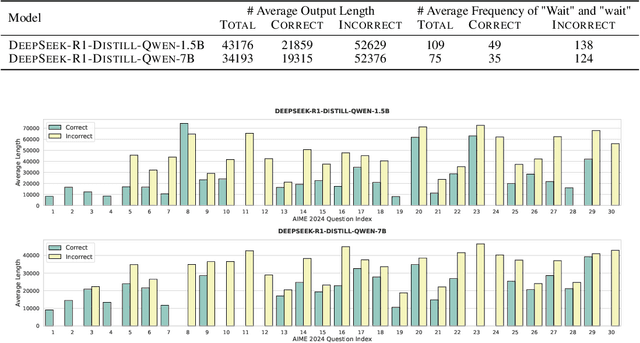

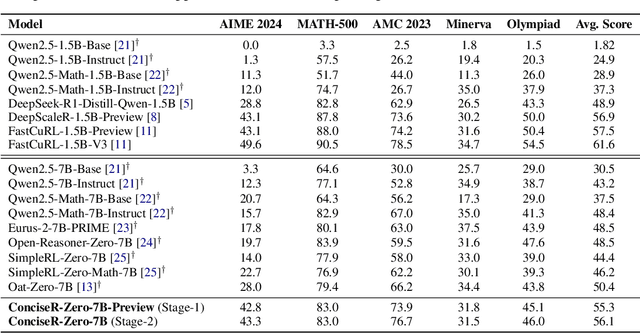
Abstract:As test-time scaling becomes a pivotal research frontier in Large Language Models (LLMs) development, contemporary and advanced post-training methodologies increasingly focus on extending the generation length of long Chain-of-Thought (CoT) responses to enhance reasoning capabilities toward DeepSeek R1-like performance. However, recent studies reveal a persistent overthinking phenomenon in state-of-the-art reasoning models, manifesting as excessive redundancy or repetitive thinking patterns in long CoT responses. To address this issue, in this paper, we propose a simple yet effective two-stage reinforcement learning framework for achieving concise reasoning in LLMs, named ConciseR. Specifically, the first stage, using more training steps, aims to incentivize the model's reasoning capabilities via Group Relative Policy Optimization with clip-higher and dynamic sampling components (GRPO++), and the second stage, using fewer training steps, explicitly enforces conciseness and improves efficiency via Length-aware Group Relative Policy Optimization (L-GRPO). Significantly, ConciseR only optimizes response length once all rollouts of a sample are correct, following the "walk before you run" principle. Extensive experimental results demonstrate that our ConciseR model, which generates more concise CoT reasoning responses, outperforms recent state-of-the-art reasoning models with zero RL paradigm across AIME 2024, MATH-500, AMC 2023, Minerva, and Olympiad benchmarks.
SSR-Zero: Simple Self-Rewarding Reinforcement Learning for Machine Translation
May 22, 2025Abstract:Large language models (LLMs) have recently demonstrated remarkable capabilities in machine translation (MT). However, most advanced MT-specific LLMs heavily rely on external supervision signals during training, such as human-annotated reference data or trained reward models (RMs), which are often expensive to obtain and challenging to scale. To overcome this limitation, we propose a Simple Self-Rewarding (SSR) Reinforcement Learning (RL) framework for MT that is reference-free, fully online, and relies solely on self-judging rewards. Training with SSR using 13K monolingual examples and Qwen-2.5-7B as the backbone, our model SSR-Zero-7B outperforms existing MT-specific LLMs, e.g., TowerInstruct-13B and GemmaX-28-9B, as well as larger general LLMs like Qwen2.5-32B-Instruct in English $\leftrightarrow$ Chinese translation tasks from WMT23, WMT24, and Flores200 benchmarks. Furthermore, by augmenting SSR with external supervision from COMET, our strongest model, SSR-X-Zero-7B, achieves state-of-the-art performance in English $\leftrightarrow$ Chinese translation, surpassing all existing open-source models under 72B parameters and even outperforming closed-source models, e.g., GPT-4o and Gemini 1.5 Pro. Our analysis highlights the effectiveness of the self-rewarding mechanism compared to the external LLM-as-a-judge approach in MT and demonstrates its complementary benefits when combined with trained RMs. Our findings provide valuable insight into the potential of self-improving RL methods. We have publicly released our code, data and models.
OpenThinkIMG: Learning to Think with Images via Visual Tool Reinforcement Learning
May 13, 2025



Abstract:While humans can flexibly leverage interactive visual cognition for complex problem-solving, enabling Large Vision-Language Models (LVLMs) to learn similarly adaptive behaviors with visual tools remains challenging. A significant hurdle is the current lack of standardized infrastructure, which hinders integrating diverse tools, generating rich interaction data, and training robust agents effectively. To address these gaps, we introduce OpenThinkIMG, the first open-source, comprehensive end-to-end framework for tool-augmented LVLMs. It features standardized vision tool interfaces, scalable trajectory generation for policy initialization, and a flexible training environment. Furthermore, considering supervised fine-tuning (SFT) on static demonstrations offers limited policy generalization for dynamic tool invocation, we propose a novel reinforcement learning (RL) framework V-ToolRL to train LVLMs to learn adaptive policies for invoking external vision tools. V-ToolRL enables LVLMs to autonomously discover optimal tool-usage strategies by directly optimizing for task success using feedback from tool interactions. We empirically validate V-ToolRL on challenging chart reasoning tasks. Our RL-trained agent, built upon a Qwen2-VL-2B, significantly outperforms its SFT-initialized counterpart (+28.83 points) and surpasses established supervised tool-learning baselines like Taco and CogCom by an average of +12.7 points. Notably, it also surpasses prominent closed-source models like GPT-4.1 by +8.68 accuracy points. We hope OpenThinkIMG can serve as a foundational framework for advancing dynamic, tool-augmented visual reasoning, helping the community develop AI agents that can genuinely "think with images".
FastCuRL: Curriculum Reinforcement Learning with Progressive Context Extension for Efficient Training R1-like Reasoning Models
Mar 21, 2025Abstract:In this paper, we propose \textbf{\textsc{FastCuRL}}, a simple yet efficient \textbf{Cu}rriculum \textbf{R}einforcement \textbf{L}earning approach with context window extending strategy to accelerate the reinforcement learning training efficiency for R1-like reasoning models while enhancing their performance in tackling complex reasoning tasks with long chain-of-thought rationales, particularly with a 1.5B parameter language model. \textbf{\textsc{FastCuRL}} consists of two main procedures: length-aware training data segmentation and context window extension training. Specifically, the former first splits the original training data into three different levels by the input prompt length, and then the latter leverages segmented training datasets with a progressively increasing context window length to train the reasoning model. Experimental results demonstrate that \textbf{\textsc{FastCuRL}}-1.5B-Preview surpasses DeepScaleR-1.5B-Preview across all five datasets (including MATH 500, AIME 2024, AMC 2023, Minerva Math, and OlympiadBench) while only utilizing 50\% of training steps. Furthermore, all training stages for FastCuRL-1.5B-Preview are completed using just a single node with 8 GPUs.
From Head to Tail: Towards Balanced Representation in Large Vision-Language Models through Adaptive Data Calibration
Mar 17, 2025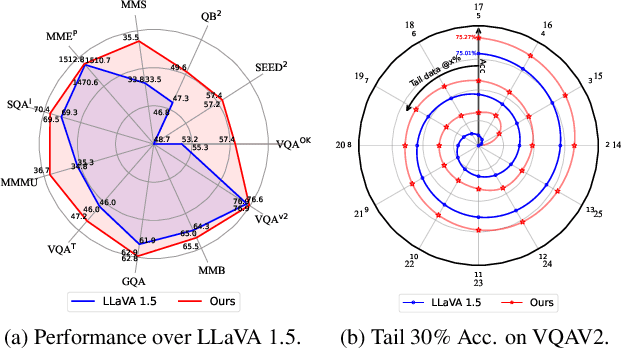
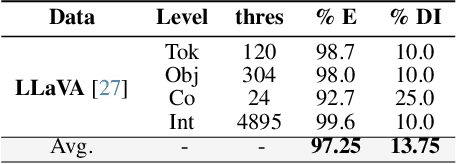
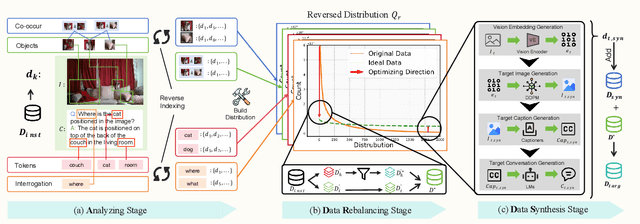
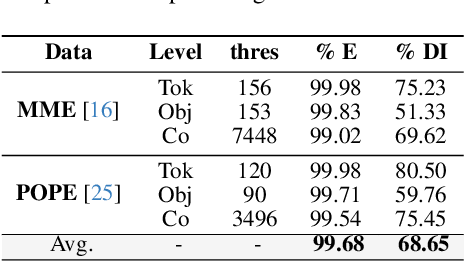
Abstract:Large Vision-Language Models (LVLMs) have achieved significant progress in combining visual comprehension with language generation. Despite this success, the training data of LVLMs still suffers from Long-Tail (LT) problems, where the data distribution is highly imbalanced. Previous works have mainly focused on traditional VLM architectures, i.e., CLIP or ViT, and specific tasks such as recognition and classification. Nevertheless, the exploration of LVLM (e.g. LLaVA) and more general tasks (e.g. Visual Question Answering and Visual Reasoning) remains under-explored. In this paper, we first conduct an in-depth analysis of the LT issues in LVLMs and identify two core causes: the overrepresentation of head concepts and the underrepresentation of tail concepts. Based on the above observation, we propose an $\textbf{A}$daptive $\textbf{D}$ata $\textbf{R}$efinement Framework ($\textbf{ADR}$), which consists of two stages: $\textbf{D}$ata $\textbf{R}$ebalancing ($\textbf{DR}$) and $\textbf{D}$ata $\textbf{S}$ynthesis ($\textbf{DS}$). In the DR stage, we adaptively rebalance the redundant data based on entity distributions, while in the DS stage, we leverage Denoising Diffusion Probabilistic Models (DDPMs) and scarce images to supplement underrepresented portions. Through comprehensive evaluations across eleven benchmarks, our proposed ADR effectively mitigates the long-tail problem in the training data, improving the average performance of LLaVA 1.5 relatively by 4.36%, without increasing the training data volume.
 Add to Chrome
Add to Chrome Add to Firefox
Add to Firefox Add to Edge
Add to Edge